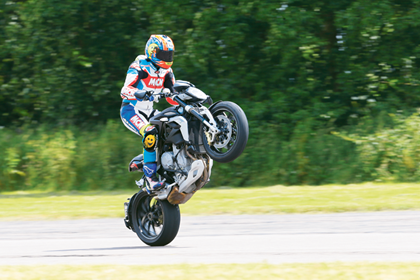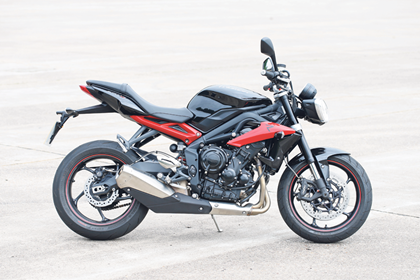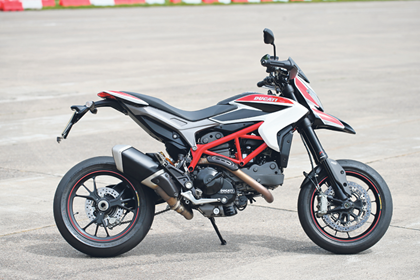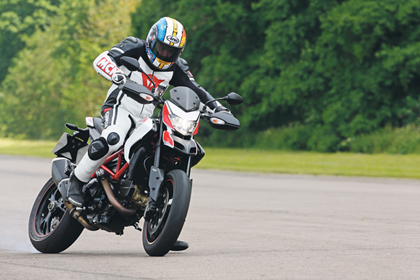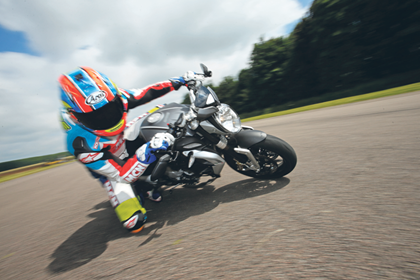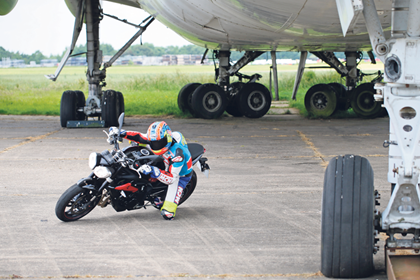Simply Ballistic: Can MV's new Dragster 800 out-gun its rivals?
The MV Agusta Dragster is the latest model to come from the iconic Italian brand – and it’s a bit of a confused beast. Using the 798cc triple and cycle parts from the Brutale 800 roadster, it has a design similar to that of Ducati’s Diavel performance cruiser and even runs a huge 200-section rear Pirelli, but more for aesthetic impact than anything else.
So it begs the question: what’s the new MV actually for? Is it a fun naked bike like Triumph’s highly-acclaimed Street Triple R, or is it more a street-supermoto, like Ducati’s Hypermotard?
The MV appears to have one wheel in each camp. The supermoto-like bar-end mirror trick was used by Ducati on the original Hypermotard, yet the MV’s bars aren’t as wide, and its stance is very different. The Dragster also has many similarities with MV’s own Street Triple roadster-rivalling Brutale 800, on which the Dragster is based. Its headlight, clocks, suspension and brakes are all identical, while the rear end looks like it’s been guillotined. Whichever way you look at it, the Triumph is bland in comparison.
Personally, I really like the look of the new MV. I love the rear end which I think is one of the best looking in the business. The triple-exit exhausts sound as good as they look, the top yoke and adjustable bars are a work of art, as are the rear indicators built into the numberplate hanger, and the hand stitching on the seat. Everywhere you look there are nice touches. Even the adjustable levers feel like they’ve been stolen from a race bike. As a result, the £10,990 asking price is (almost) justified. It’s got huge Brembo brakes, multi-adjustable suspension, switchable rider modes, ABS, traction control, a quickshifter as standard, and it says MV on the side.
But what about the riding experience? Well, the MV’s inline three-cylinder just wants to party. It just wants to rev and go ballistic, like an old-school 500cc two-stroke. The acceleration is so ferocious, I honestly thought the speedo was in kph at first. Just one bang of power after the next; you don’t feed it in, you flick it like a light switch and hold on tight.
But there’s a flip side to all that fun. It’s hard to modulate the throttle, it’s either all or nothing. The fuelling isn’t bad, it’s just so aggressive. Ask for 40% throttle, and it feels like it’s giving you 70%. Of course you can personalise and choose a custom engine map, or revert to rain mode to calm it all down.
Thankfully the Brembo radial stoppers are also impressive. A 44-metre stopping distance from 70mph makes it the best braking bike MCN has ever tested. That said, we did feel a little let down by the Dragster’s handling. The rear 200-section tyre slows the steering, but as it’s so light (at 167kg dry) that’s not our biggest gripe: it’s the rear suspension. It feels like there is no control or support. Small imperfections in the Tarmac get the rear tyre working overtime, throw in some bigger ones and it starts to get in a real mess. You have to wait for the shock to settle before you can do anything. All of which robs you of confidence.
By contrast, the Street Triple R feels as if someone’s fitted an invisible steering damper. Compared to the MV it’s definitely heavier, and the legendary 675cc triple engine feels lazy in comparison to the manic MV, too. I never thought I’d say that.
But the Triumph’s engine is not a million miles behind and it sounds amazing. The Triumph would undoubtedly be the quickest around a track, too, thanks to its predictable handling, allowing it to run rings around the MV.
The Street Triple’s fuelling is also perfect. It’s easy to loft the front wheel in the first few gears then just dial in another gear to deliver smooth and effortless wheelies. You can either ride it using the mid-range, listening to the lovely induction noise, or tuck in and make it scream until the shift lights flicker on. The Triumph may lack the aggressive wow factor of the other two, and doesn’t have traction control or riding modes, Brembo this, or Öhlins that, but the British bike is nearly £3000 less than the MV and nearly £4000 shy of the Ducati. That’s a lot of value for money.
Which brings me to the Ducati. Can someone please pass me a step ladder? I’d forgotten how big the Hypermotard SP is. I’m 5ft 7in and the Hypermotard SP is tall with a seat height of 890mm. Normally this isn’t an issue but compared to the MV (811mm) and Triumph (805mm) it feels huge. It feels very different, too. You’re further forward in the seat with your bodyweight more over the front and you’re sat on it rather than in it. It takes a little getting used to.
But once you’re sitting comfortably, the Ducati really turns back the clock, giving you the bravado of a teenager and making you do things you really shouldn’t. Co-tester Neevesy couldn’t bring himself to use both wheels for anything other that stopping, or sliding into corners. The Ducati also has a host of rider aids, like switchable traction control and ABS intervention which alter according to which rider mode you’ve selected. There’s a noticeable difference between these modes, too. We personalised road mode to reduce ABS and remove traction control, while in race mode we had full power. It’s relatively easy to do, and it saves your settings once you’ve turned the bike off.
With all the rider aids deactivated the Hypermotard becomes a playful toy. It’s light, easy to manage with a big kick of mid-range from its 821cc twin. You can afford to be lazy with the throttle and still have fun. The steering is light and accurate and despite its tall stance it’s stable at speed, even if you throw a few bumps and crests in. That said, you always feel a little distant from the contact patch as its suspension travel is so long. The Ducati’s brakes are also impressive: big Brembos with excellent ABS.
But compared to the MV it feels sluggish and lacks top end rush. Around a tight track like Cadwell Park or Mallory it’d be in its element. At somewhere open like Silverstone it’d be a pain.
At almost £12k you have to ask where all the money goes. The MV looks like it should be worth over £10,000, while the Ducati Hypermotard doesn’t.
THE VERDICT:
Of the three bikes here, there’s one I’d buy, one I’d recommend, and one I lust after.
I want the MV, but I’d never buy one; the handling and power delivery need sorting.
I’d recommend the Ducati. It has more than enough power and is an ideal back-lane scratcher. But it’s too expensive and impractical.
The one I’d buy is the Triumph. It’s not the sexiest, nor the most fun, but it is a brilliant bike in almost every area. I can’t recommend it enough. Why would you want anything else? It’s one of the best road bikes of 2014.
To check out the best prices for both new and used models, visit MCN Bikes for sale here >
